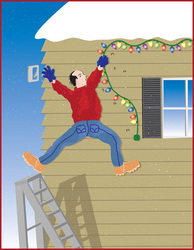
The holiday festivities are here.The annual hanging of lights and decorations from eves, gutters, walls, banisters and any other surface we can reach on our home begins.For some, this is the only time of year the dusty ladder is pulled out of hiding.Little thought is given to how this tool is purchased or used safely.Ladders are labeled with duty ratings.Type I, the industrial ladder, holds 250 pounds.Type II holds up to 225 pounds.Type III, the household ladder, holds up to 200 pounds.Remember to include the weight of the tools or materials you plan to use.If you work around electrical wires, don't choose a metal ladder.A number of accidents occur each year because power lines and equipment wires contact metal ladders.Use a dry wooden or nonconductive fiberglass ladder for this kind of work.Using a Ladder.Make sure the ladder is suited for the type of job you plan to do (see the types above).Before using a ladder, especially a ladder that has been stored in the garage for a while, inspect it for cracks or broken joints.Place your ladder on a stable, even, flat surface.Never place a ladder on top of another object.Use the 1.4 ratio to ensure a stable working platform.Place the base of the ladder 1 foot away of whatever it leans against for every 4 feet of height to the point where the ladder contacts at the top (see graphic).When using an A-frame stepladder, make sure the brace is locked in place.If climbing onto another surface (like a roof,) make sure the ladder extends at least three feet past the platform you're climbing onto.Secure tall ladders by lashing or fastening the ladder to prevent movement.Always face the ladder when climbing or descending.Keep both feet on the ladder - never put one foot on a rung and the other foot on a different surface.Do not climb higher than the second rung on stepladders or the third rung on straight or extension ladders.Never stand on the top or the paint shelf of a stepladder.Keep your belt buckle (if you have one) positioned between the rungs so it doesn't catch.Never leave ladders unattended - kids love them.Never over reach, climb down and move the ladder.Do not place a ladder on an icy surface.When working with electricity, use a ladder made of wood or fiberglass.Maintaining Ladders.Inspect ladders regularly.Stepladders and extension ladders should be inspected for broken or frozen joints or latches.Aluminum ladders should be inspected for cracks and broken welds.Aluminum ladders should also be inspected for rough spots and burrs before first use.Wood ladders should be inspected for cracked wood, splinters, and rot.Look for broken or loose hardware.Protect wood ladders with linseed oil or clear sealant.Never paint a wooden ladder - the paint may hide imperfections such as rot or cracks.Fiberglass ladders are protected with a clear sealant.If the fiberglass is damaged through the sealant, sand lightly before applying another coat of lacquer.

No comments:
Post a Comment